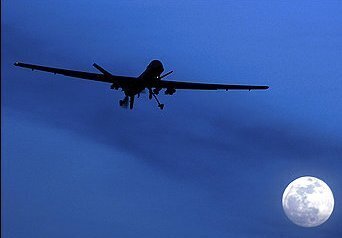
Last week, U.S. drones reportedly struck a gathering of tribal elders in northern Pakistan, killing a significant number of civilians and sparking local outrage as well as rare denunciations from Pakistan's political and military leadership. The U.S. provided no official explanation for allegedly killing innocent civilians at a legitimate community meeting; instead, an anonymous official said simply: "These people weren't gathering for a bake sale."
Such is the typical U.S. explanation and legal justification of its drone strikes in Pakistan. Instead of public oversight, information and investigations, silence or sly remarks from anonymous U.S. officials are what pass for accountability. As a result, the legal basis for strikes -- in this case, specifically, how and on what basis the U.S. identifies and targets individuals as combatants -- is unknown.
To be clear, the U.S. is no longer carrying out a small-scale assassination program with drones in Pakistan, targeting only high-level terrorists selectively approved by CIA legal and intelligence officials. In recent years, the program has undergone a dramatic expansion.
Now, the vast majority of those targeted and killed by drones are lower-level militants, whose identities are usually unknown, never mind subject to rigorous legal review. Determinations of combatant status are consequently based on more circumstantial evidence and factors unrelated to individual-specific intelligence. With a much lower threshold for using lethal force and broader scope of potential targets, civilians are at much greater risk -- especially from a potentially ill-defined and overbroad definition of combatancy.
Since 2008, despite an almost four-fold increase of drone strikes, the U.S. claims to have simultaneously reduced civilian casualty rate from such strikes to around 1-2%. Though evidence intelligence and technological improvements have enhanced accuracy, such a low civilian casualty figure is cause for skepticism.
In Afghanistan, civilian casualties from U.S. and ISAF operations regularly demonstrate the very real, tragic potential for mistakes, negligence, and at times even criminal behavior during military operations. Such casualties occur despite the considerable land, air, intelligence and other assets that the U.S. and its allies have at their disposal--none of which exist in Pakistan. In my own reporting, I have documented numerous incidents of civilian casualties from drone strikes -- over 30 civilian deaths in nine cases alone -- casting serious doubt on U.S. casualty estimates.
One possible, very troubling explanation is that the standard applied by the U.S. to determine combatancy is too broad. As a result, innocent civilians are either being targeted or are not properly considered in proportionality calculations.
After last week's strike, for example, numerous news organizations reported that while Taliban fighters may have been among those targeted, many of the dead were tribal elders that had gathered to settle a dispute over local mining operations. The Taliban were reportedly involved in brokering a settlement.
Though the meeting was in fact "no bake sale," as the American official put it -- it may nevertheless have been just as innocent.
Under international law, merely meeting or interacting with terrorists, the Taliban, al-Qaeda or their affiliates does not transform someone into a combatant who can be targeted in an attack. That kind of guilt-by-association logic is precisely the kind of terrorist rationale that justifies attacks against UN aid workers, Afghan politicians, or U.S. diplomats -- which the U.S. rightly condemns as terrorism and war crimes.
In an area like North Waziristan, which has been ceded to militant groups, civilians often have no choice but to engage with militants. In interviews I've conducted with people from tribal regions, including North Waziristan, many had little sympathy for militant groups. Nevertheless, they were left with little choice in a place where neither the Pakistani government nor the U.S. military have an effective presence.
In North Waziristan, control over land, water and other resources are frequent sources of dispute, as in any other part of the world. A tribal jirga, or meeting is often convened to resolve differences. And in North Waziristan, where the state has no de facto control and there are no formal legal institutions, local militant groups may act as mediators or even conveners of such gatherings, as was reportedly the case last week. In such circumstances, economic necessity and political realities compel engagement with militant groups -- not a desire to support militants' cause against the U.S.
In fact, even if the tribal elders were political supporters, sympathizers or donating their proceeds from a bake sale to militants they still would not have been legitimate targets -- so long as they didn't directly participate or cause harm in attacks on the U.S. It's the same reason why a Taliban attack on a U.S. politician who supports the war or American taxpayers that provide funding is impermissible.
However, it is unclear whether the U.S. is respecting this standard of combatancy. When drones strike tribal elders meeting with a number of militants over a local land dispute, killing up to 40 people, there are serious, legitimate questions raised about the legality of such attacks. Yet the U.S. continues to invoke secrecy as an excuse for silence.
With credible reports of significant civilian losses and strong condemnation from the Pakistani government, the need for the U.S. to come clean about drone strikes has never been clearer. Distinguishing militants from civilians in northern Pakistan may be challenging. Yet the onus is on the U.S. to demonstrate that civilian casualties are as low as it claims and that combatant-status is properly defined and applied. Anonymous, unverifiable leaks and self-assured quips about bake sales can no longer be considered adequate or appropriate responses to civilian losses and potential violations of international law.